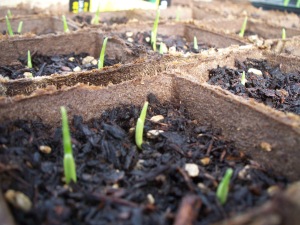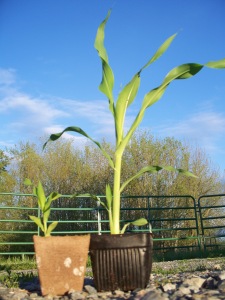Sometimes I wonder why people with the same diagnosis can vary so dramatically in how they respond to treatment. Same disease, same treatment, yet vastly different response. What’s going on?
This spring I did some experimenting. Here’s a picture of my corn one week after it was planted:
Here’s a different picture of plants that were grown with seeds from the same package, planted in potting soil from the same bag, planted on the same day, and kept side-by-side in the same greenhouse:
One would expect them to be the same size. Obviously they’re not.
After six weeks, the difference was even more pronounced:
The only difference is the pots.
At three weeks, there was such a difference in how well the plants were growing that I begged more plastic pots from friends and transplanted most of the corn out of peat pots and into plastic. The change in environment couldn’t make up for their slow start, but it definitely helped. The corn that was always in a plastic pot was two feet high. The corn that was always in a peat pot was about seven inches tall. In between the two extremes, the corn that changed from the “bad” pots to the “good” pots took off and did reasonably well – not as tall as the corn that started in plastic, but double the height of the corn that never got out of the peat pot.
Lest you think this is a phenomenon peculiar to corn:
I won’t post more pictures, but you get the idea. Everything did better in plastic pots than in peat pots.
There were minor differences with different types of potting soil, minor difference with different locations in the greenhouse (full sun vs morning shade), and even small differences between round and square pots. The differences were small, and might be written-off to the variability of seed. More research would be needed to know for sure. There’s no question about pot-type, though. The difference between type of pot was enormous with every type of seed I started.
All of which brings me back to people’s response to medical treatment. Just as there are things that can help plants grow better, there are things that can help RA patients do better. Exercise is good for people with RA. Smoking is bad for people with RA. Diet can make a difference for some people with RA.
Why is it so hard to find basic information about living as best as is possible with an RA diagnosis? Probably for the same reason that gardening centers sell peat pots. Change is hard. It’s easier to go along with the way things have always been done than it is to stretch and try something new.
I know I’ve started three different series (and not completed any of them), but I believe I’ll be adding posts on little things we can do to help us thrive despite RA, instead of merely survive.






My seedlings have always done great with peat pots of any size! My guess would be that your peat pots look dried out??? But you are correct about us needing individualized treatments.
The thing is, the plants in peat pots looked fine. It was only when compared to plants in a different situation that it was obvious that they could be doing better than they were.
I tried same amount of water for everything, but it became apparent that water evaporated through the peat pots and not through the plastic. There were a couple days that I even set the peat pots in trays of water – which made the pots start to mildew. I finally tried to just go by how moist the soil was. Maybe there’s a better way to get them just the right amount of water, but I don’t see (for myself) going and spending money on peat pots when I already have a bunch of plastic pots that seem to work so much better for me 😉
Individual treatment.. It sure would be nice if there were a basic thing we could all do to improve our chances!
Unfortunately I have found in our medical community at large that the only thing to do for ra is write a prescription which as your plant experiment showed…may work great for some but not for all. I wish we could get more support on thriving with ra through foods, vitamins and non traditional treatments in conjunction with the traditional. I often feel like I am swimming up river on my own with the “non traditional”. It shouldn’t have to be this way but sadly it is.
Sometimes I wonder if doctors just don’t say anything since so many patients don’t follow through. It must get discouraging to tell people how they can be healthier and have them not be interested; maybe some docs give up after a while. I asked my rheumatologist if there was anything else I could do, besides my meds and my PT exercises, and she recommended Tai Chi. No classes anywhere around, but I’m still looking (and asking, hoping someone will put a class on their fall schedule).
Tips on diet and other legitimate non-pharmaceutical things we can try would be great, and they’re hard to find.
Guess there is no good anser at this time. Probably cause it is a diferent pathway to a smilar end result for everyone and not enough trying on docs or pts parts to keep trying new things. I’ve been just surviving for so many years. Just recently changed med regimine a bit and doing better towards maybe thriving. Keeping fingers crossed the trajectory up continues.
As a physician, I would say we are like peat pots. Maybe adequate for some purposes, but very narrowly trained and narrowly focused, especially narrow as one sub-specializes in a hospital based (and Medicare funded) fellowship, even though it looks like it’s out-patient care. The world of family, friends, community, church, and God have a lot more to offer. Together, they might even be better than plastic pots for growth in health and life.
Patients get trapped when they live in the peat pot of medical insurance and think it has something to do with their health. You have DISEASE oriented doctors and DISEASE oriented insurance. It will get much worse as Wall Street and shareholder value collude further with the Medical-Industrial Complex to suck every penny they can out of your body parts and your DNA. DO NOT rely on your physician for your health if you want health. There’s no money in health at the present time for doctors or hospitals. Our profession has failed you, except for our ability to prescribe very effective drugs for small groups of people. I worry when I read so many comments on the www expecting physicians to be health oriented, when I know how they are trained to be MEDICAL, (even the Family Physicians who speak of health frequently -at a financial loss- are trained in the same kind of Medicare funded, hospital based residencies as your sub-specialists).
The two flagship hospitals for the two warring systems in my area both closed their Family Medicine training centers and opened new heart hospitals that train cardiologists. Their internist trainees all shun primary care careers, (which cheats the system by talking about health from time to time). Across the nation, similar things are happening so your parts are closer to expensive technology that will continue to be overused. Current estimates are that we generate around 30,000 cancers per year with CT scans that were done 15-20 years ago and 100,000 deaths annually from MEDICAL therapies. Get a plastic pot for your health, not a DISEASE oriented MEDICAL peat pot. My apologies to you for the misdirection of my profession. Just my thoughts.
A P Jonas, MD, Family Physician
Socks: As always you’ve provided a thought-provoking lesson with a brilliant analogy. Thank you.
Much to think about here. . .thank you Socks and Dr. Synonymous. Right now we are left to ourselves to figure out how to make the best of it. And some of us do that better than others.
Sherry
Your words and the pictures really bring home individual differences. Thanks for this analogy that I will try to remember.
This was a really great and imaginative post. The metaphor really struck a cord with me and made me think of those with JRA.
I was wondering if you or Dr. Synonymous might have any information or links associated with this type of technology?
http://www.dailyrx.com/news-article/sonography-helps-identify-juvenile-inflammatory-arthritis-children-13484.html
The researchers in this study are utilizing a combination of sonogram in league with the general physical exam to detect arthritis in children.
Warmsocks, I love this post. Fantastic! I too find it interesting that we each respond to the same disease differently not only in our own choices but the choices provided by our health care providers. Very interesting. I am looking forward to your new series on “thriving”.
Hi Warmsocks, I embrace this series whole-heartedly! 🙂 I’ve had some people (both RA patients and non-patients) be angry with me for my positive approach and brand of Thrive With RA™. I would liken those that choose this limiting, “glass half-empty” view to the stunted plant in the peat pot! I want to continue to grow, despite RA. Gimme the plastic pot every time! Thanks for the visuals!
Thrive With RA™
Hi Warmsocks, I LOVE this post. It has really given me food for thought. I feel like a seed in a peat pot, but there is lots I can do to make it a better pot. Thank you for this thought provoking insight.
Thank you so much! I’ve just started humira myself 4 months ago, and am rather disappointed with the results. I love your plant pictures though because it does put things so eloquently in pictures. I am going to stick with the humira a while longer, and keep stretching and going for acupuncture and see if one, or all of these things, can put me on a better trajectory!
Melissa
Hope you’re doing well, and that your silence is just a good sign that you’re off enjoying your summer!!!